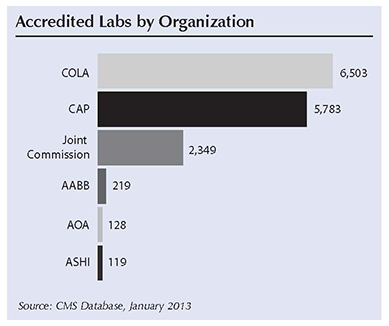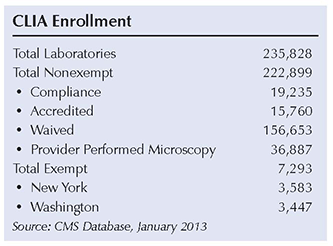Almost two years after first being proposed, a rule allowing patients to have direct access to their laboratory test results is expected to be finalized by late summer or early fall, according to Judy Yost, director of the Division of Laboratory Services at the Centers for Medicare and Medicaid Services (CMS).The rule currently is being reviewed by the secretary of Health and Human Services and will then go to the Office of Management and Budget for final review before publication. Yost discussed the rule June 19 during a G2 Intelligence webinar, “Keeping Ahead of the Curve: CLIA Compliance 2013.”
The proposed rule, published Sept. 14, 2011, would modify regulations under both the Clinical Laboratory Improvement Amendments (CLIA) and the Health Insurance Portability and Accountability Act. Currently, under CLIA regulations, patients in states that do not provide individual access to test results must request and receive results through their health care provider. At the time the proposal was published, 39 states prohibited a laboratory from releasing a test report directly to a patient without the consent of the health care provider.
While many larger labs that operate in multiple states already have processes in place for release of test results directly to patients, smaller laboratories may face significant costs in adapting their processes and systems to accommodate such changes. Yost says the final rule will specifically address the burden on laboratories.
Once the rule is published, CLIA Interpretive Guidelines for Laboratories will be revisited to ensure laboratories and stakeholders have clear guidance on best practices and resources to implement the technology that will be required to comply with the rule.
PT Regulations
CMS is continuing work on updating proficiency testing (PT) regulations in collaboration with the Centers for Disease Control and Prevention (CDC). The agencies currently are gathering and analyzing data and reviewing analyte lists, grading criteria, and target values.
CMS also is finalizing proposals that would modify CLIA rules that govern the referral of PT samples. Previously, CLIA had adopted a strict interpretation of the term
intentional referrals, stating that when a lab for any reason referred a PT sample to another lab for analysis, it had no choice but to impose the harshest sanctions: revocation of the lab’s CLIA certification and its approval to receive Medicare and Medicaid payment for one year, as well as barring the lab’s owner and operator from owning or operating another lab for two years from the date of revocation.
However, Congress last year passed the Taking Essential Steps in Testing (TEST) Act, which gave CMS discretion in using its enforcement authority to consider penalties on a case-by-case basis for breaches of the PT referral rules.
Subsequently, CMS on Feb. 7, 2013, published a proposed rule that would carve out a one-time exception for confirmatory and reflex testing if the PT sample goes to another lab for testing. Described by CMS as “an infrequent and narrowly crafted carve-out from the long-standing interpretation of ‘intentional,’” the exception would apply only to a laboratory that refers a PT sample to another laboratory for confirmatory or reflex testing in accordance with the laboratory’s standard operating procedures for patient testing.
As long as the PT referral is not a repeat referral (i.e., no other PT referral occurred during the two survey cycles prior to the time of the PT referral at issue), CMS would consider the referral to be “improper” rather than “intentional” and would impose alternative sanctions rather than revoke a laboratory’s CLIA certificate. The final rule should be out late this year.
The next step in implementing the TEST Act, says Yost, is a rulemaking to detail adverse actions for PT referrals—defining when the discretion will be applied and when revocation will be imposed.
Individualized Quality Control
CMS has revised quality control (QC) guidelines to incorporate risk-management principles used in manufacturing and other industries contained in Clinical Laboratory Standards Institute guidance, called EP-23, which was published in October 2011. Under EP-23, labs should consider what could go wrong in their operations and take into account a host of factors, such as specific device capabilities, package-insert recommendations, literature about the test, the laboratory setting, operator experience, how the test will be used in medical care, and local quality regulations. CMS has incorporated key EP-23 concepts into its guidelines, and it is now called individualized quality control plan (IQCP).
IQCP applies to CMS-certified nonwaived labs and covers all phases of the testing process. The plan is optional and may or may not reduce the QC amount or frequency, notes Yost. IQCP covers existing and new analytes, test systems, and specialties, except cytology and histopathology.
According to Yost, the IQCP can be customized based on patient population, environment, test system, personnel, and test uses. It also offers flexibility to achieve QC compliance for each test and is adaptable to future technology advancements. In addition, IQCP permits labs to develop a QC plan using their existing quality practices and information, considers known risks mitigated by manufacturers, and formalizes laboratories’ risk-management decisions.
Once effective, IQCP will supersede CLIA’s current equivalent quality control policy, says Yost. However, existing regulations will not change, nor will existing QC concepts change. National surveyors will be trained on IQCP, and there will be an education and transition period for labs before IQCP is fully effective, she adds.
Recordings of the June 19 CLIA webinar may be purchased at www.G2Intelligence.com or by calling 800-531-1026.
Meantime, CMS-certified labs should continue to follow existing QC protocols, learn about EP-23 and IQCP, and plan and complete their transition by phasing out existing QC and deciding to implement either default QC or IQCP, advises Yost. CMS will notify labs of when the transition and education period begins and ends. At the end, labs must be in compliance with the QC program of their choice or deficiencies will be cited.
CMS will solicit accrediting organizations (AOs) to determine their interest in IQCP, says Yost. Accredited labs should continue to meet their AO’s QC standards until they hear otherwise from their AO. More information on IQCP is available at
www.cms.gov/clia. Questions about the alternate QC option may be sent to
IQCP@cms.hhs.gov.
Competency Assessment
Laboratories should be assessing the competency of lab personnel on an annual basis (all technical, supervisory, and testing personnel). New guidance from CMS defines
competency as the ability of laboratory personnel to apply their skill, knowledge, and experience to perform their duties correctly. “Competency is not the same thing as proficiency testing,” explains Yost. “PT can be used to meet some elements of competency, but not all.”
The individual conducting the competency assessment must be qualified to do so. Depending on the complexity of the testing involved, the individual must be qualified as a technical supervisor, general supervisor, or technical consultant.
The six elements of competency assessment must be completed for each person, each test, each year:
- Direct observation of routine patient test performance, including patient preparation, if applicable, specimen handling, processing, and testing.
- Monitoring the recording and reporting of test results.
- Review of intermediate test results or worksheets, QC records, PT results, and preventive maintenance records.
- Direct observation of performance of instrument maintenance and function checks.
- Assessment of test performance through testing previously analyzed specimens, internal blind testing samples, or external PT samples.
- Assessment of problem-solving skills.
Competency records should match the laboratory’s actual procedures as performed by its personnel, advises Yost. When observing test performance, use the procedure manual package insert to ensure the information is current and is being followed. Competency for clinical and technical consultants and supervisors is based on their regulatory responsibilities.
Labs don’t have to do competency assessment all at one time; it can be spread out through the year, notes Yost. Elements such as preanalytic, analytic, and post-analytic can be combined. Assessors can also combine analytes tested on the same platform but not test systems with different platforms, methods, or manufacturers.
Ultimately, the lab director is accountable for all competency assessments, and the director must also demonstrate proficiency. Yost advises building competency assessment into existing quality practices and procedures as part of the lab’s QC system.
Good Practices for Waived Testing
CLIA officials, in conjunction with CDC, have developed education material designed to assist labs that perform waived testing. “Ready? Set? Test!” comes in a poster and booklet format. The poster reminds testers of 10 important practices to follow for accurate and reliable testing, while the booklet describes recommended practices for physicians, nurses, medical assistant, pharmacists, and others who perform patient testing under a CLIA certificate of waiver. CLIA and CDC also have developed an online course for health care professionals performing testing in waived testing sites.
To see how effective the materials are, CMS conducted a pilot study involving two states in each region. Selected waived labs received a copy of the “Ready? Set? Test!” booklet prior to their certificate-of-waiver survey. Post-survey information was collected regarding lab use of the booklet to improve lab practices. In 2010, the baseline year, only 18 percent of surveyed waived labs received letters of congratulations from surveyors. This figure increased to 32 percent in 2011 and 44 percent in 2012.
The conclusion of the study, says Yost, is that educational materials do actually help improve the quality of laboratory testing. The materials are available on both the CLIA Web site and on the CDC Web site at
www.cdc.gov (search for “waived tests”).

